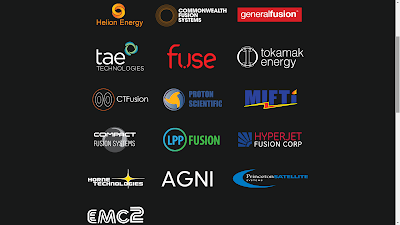The new Fusion Industry Association is mentioned in the article excerpt below. The Fusion Industry Association is a registered non-profit organization composed of private companies working to commercialize fusion power. The Association advocates for policies that would accelerate the race to fusion energy. From the Massachusetts Institute of Technology (MIT) Plasma Science and Fusion Center (click here):

A new report on the development of fusion as an energy source, written at the request of the U.S. Secretary of Energy, proposes adoption of a national fusion strategy that closely aligns with the course charted in recent years by MIT’s Plasma Science and Fusion Center (PSFC) and privately funded Commonwealth Fusion Systems (CFS), a recent MIT spinout.
It recommends continued U.S. participation in the international ITER fusion facility project and “a national program of accompanying research and technology leading to the construction of a compact pilot plant that produces electricity from fusion at the lowest possible capital cost.”
That approach (which the report says would require up to $200 million in additional annual funding for several decades) leverages opportunities presented by new-generation superconducting magnets, reactor materials, simulators, and other relevant technologies. Of particular emphasis from the committee is the advances in high-temperature superconducting magnets which can access higher fields and smaller machines. The report recommends a U.S. program to prove out high-field large-bore magnets. They are seen as enabling faster and less-costly cycles of learning and development than extremely large experiments like ITER, which will not come on line until 2025, while still benefitting from the knowledge that emerges from those programs.
This smaller-faster-cheaper approach is embodied in the SPARC reactor concept, which was developed at the PSFC and forms the foundation of CFS’s aggressive effort to demonstrate energy-gain fusion by the mid-2020s and produce practical reactor designs by the early 2030s. This approach is based on the similar conclusion that high-field high-temperature magnets represent a game-changing technology.
A $30 million program between CFS and MIT to demonstrate the high-field large bore superconducting magnets is underway at MIT and is a key step to a compact fusion energy system. Despite a handful of other privately funded fusion companies having offered roughly comparable (10 to 15-year) timelines, the National Academies report does not envision demonstration fusion reactors appearing until the 2050 time frame (my emphasis).
“The National Academies are a very thoughtful organization, and they’re typically very conservative,” says Bob Mumgaard, chief executive officer of CFS. “We’re glad to see them come out with a message that it’s time to move into fusion, and that compact and economical is the way to go. We think development should go faster, but it gives validation to people who want to tackle the challenge and lays out things we can do in the U.S. that will lead toward putting power on the grid.”
Andrew Holland, director of the recently formed Fusion Industry Association and Senior Fellow for Energy and Climate at the American Security Project, notes that the report’s authors were charged with creating “a consensus science report that reflects current pathways, and the current pathway is to build ITER and go through the experimental process there, while meanwhile designing a pilot plant, DEMO.”
Shifting the consensus toward a faster way forward, adds Holland, will require experimental results from companies like CFS. “That’s why it’s notable to have privately funded companies in the U.S. and around the world pursuing the scientific results that will bear this out. And it’s certainly important that this study is aimed at getting the government-based science community to think about a strategic plan. It should be seen as part of a starting gun for the fusion community coming together and organizing its own process.”
Or, as Martin Greenwald, deputy director of the PSFC and a veteran fusion researcher, puts it, “There’s a tendency in our community to argue about a 20-year plan or a 30-year plan, but we don’t want to take our eyes off what we need to do in the next three to five years. We might not have consensus on the long scale, but we need one for what to do now, and that’s been the consistent message since we announced the SPARC project — engaging the broader community and taking the initiative.
“The key thing to us is that if fusion is going to have an impact on climate change, we need answers quickly, we can’t wait until the end of century, and that’s driving the schedule. The private money that’s coming in helps, but public funding should engage with and complement that. Each side has an appropriate role. National labs don’t build power plants, and private companies don’t do basic research.”
The MIT article continues as linked above.
It looks as though I have more research to do. I have identified 21 currently active fusion power development programs (click here), but there may be a few more to explore, via their memberships in the new Fusion Industry Association.... Note that while primarily US companies are represented, the membership of the Fusion Industry Association is already international.
Note: The Fusion Industry Association is also on Twitter (click here).
_





No comments:
Post a Comment